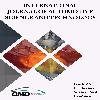Numerical investigation of the effect of different heat sink fin structures on the thermal performance of automotive LED headlights
With the developing technology, the automotive lighting sector is also changing rapidly. Automotive lighting equipment is produced with more functionality and higher performance. However, with the increase in perfor-mance, undesirable heat generation also increases. Automotive headlights fail or perform poorly when exposed to high heat; therefore, unwanted heat has to be removed. This is accomplished with heat sinks. In this study, four different automotive light-emitting diode (LED) headlights have been designed as channelless, 4-channel, 8-channel, and 12-channel. The designed models were tested numerically at different LED powers (8, 10, 12, 14, and 16W). Thus, the impact of heat sink fin structures on the thermal performance of automotive LED headlights was investigated numerically. The heat dissipation performances of the designs were analyzed using the computational fluid dynamics software SolidWorks Flow Simulation. The simulation results showed that the designed products can be used as LED headlights. As the applied heat power increased, maximum tem-peratures also increased. While a continuous increase in performance was achieved in designs up to 8-channel, slight performance degradation was observed when the number of channels reached 12. As the applied heat power increased, the average temperatures increase whereas thermal resistance (Rth) decreased. From channel-less design to 12-channel design, Rth values decreased from 6.8 °C/W to 5.31 °C/W.
Keywords:
LED headlights, Heat sink, Fin structure Thermal performance, Numerical investigation, Impact of channel,
___
- [1] Jang D, Yu SH, Lee KS. Multidisciplinary optimization of a pin-fin radial heat sink for LED lighting applications. Int J Heat Mass Transfer 2012; 55: 515–521.
- [2] Costa VAF, Lopes AMG. Improved radial heat sink for led lamp cooling. Appl Therm Eng 2014; 70: 131–138.
- [3] Jeong MW, Jeon SW, Kim Y. Optimal thermal design of a horizontal fin heat sink with a modified-opening model mounted on an LED module. Appl Therm Eng 2015; 91: 105–115.
- [4] Hsu HC, Huang YC. Numerical simulation and experimental validation for the thermal analysis of a compact LED recessed downlight with heat sink design. Appl Sci 2017; 7: 4.
- [5] Şevik S, Abuşka M, Özdilli Ö. Thermal performance analysis of a novel linear LED housing with inner and outer fins. Int Commun Heat Mass Transfer 2020; 119: 104970.
- [6] Şevik S, Özdilli Ö. Design and thermal analysis of led downlight heat sink. 4. Asia Pacific International Congress on Contemporary Studies, 12-13 December 2020, Published: 25 December 2020, Subic Bay, Philippines.
- [7] Şevik S, Özdilli Ö. Experimental and numerical analysis of the splay impact on the performance of splayed cross-cut fin heat sink. Int J Therm Sci 2021; 170(4): 107101.
- [8] Dewar Robert E, Olson P. Human factors in traffic safety. 2nd ed., Tucson: Lawyers & Judges Publishing Company, 2007.
- [9] Bullough John D, Donnell Eric T, Rea Mark S. To illuminate or not to illuminate: roadway lighting as it affects traffic safety at intersections. Accid Anal Prev 2013; 53: 65–77.
- [10] Long X, He J, Zhou J, Fang L, Zhou X, Ren F, Xu T. A review on light-emitting diode based automotive head-lamps. Renew Sustain Energy Rev 2015; 41: 29–41.
- [11] Jianghong J, Ben W. High efficiency reflector optics for LED automotive forward lighting. SPIE Proceedings Of Nonimaging Optics and Efficient Illumination Systems IV, 2007; 6670: 1–10.
- [12] Chi-Chang H, Yan-Huei L, CHih-Ching H. Modular design of the LED vehicle projector headlamp system. Appl Opt 2013; 52: 5221–9.
- [13] Ge A, Du Z, Wang W, Qiu P, Wang J, Cai J., et al. A composite optical system for a LED based headlamp low beam module. Ligh Res Technol 2013; 45: 752–7.
- [14] Cvetkovic A, Dross O, Chaves J, Benitez P, Miñano JC, Mohedano R. Etendue-preserving mixing and projection optics for high-luminance LEDs, applied to automotive headlamps. Opt Express 2006; 14: 113014–20.
- [15] Jang S, Shin MW. Thermal analysis of LED arrays for automotive headlamp with a novel cooling system. IEEE Transactions on Device and Materials Reliability 2008; 8(3): 561–564.
- [16] Lai Y, Cordero N, Barthel F, Tebbe F, Kuhn J, Apfelbeck R, Würtenberger D. Liquid cooling of bright LEDs for au-tomotive applications. Appl Therm Eng 2009; 29: 1239–44.
- [17] Chen S, Chen K, Li Z, Tang Y, Zhuang B, Zhong G, Liang G. Experimental investigation on the thermal perfor-mance of a light emitting diode headlamp with a flexible woven heat sink. Appl Therm Eng 2017: 127: 1215–22.
- [18] Huang DS, Chen TC, Tsai LT, Lin MT. Design of fins with a grooved heat pipe for dissipation of heat from high-powered automotive LED headlights. Energy Conver Manage 2019; 180: 550–558.
- [19] Lu Z, Bai P, Huang B, Henzen A, Coehoorn R, Liao H, Zhou G. Experimental investigation on the thermal per-formance of three-dimensional vapor chamber for LED automotive headlamps. Appl Therm Eng 157 (2019) 113478.
- [20] Sökmen KF, Yürüklü E, Yamankaradeniz N. Computational thermal analysis of cylindrical fin design parameters and a new methodology for defining fin structure in LED automobile headlamp cooling applications. Appl Therm Eng 94 (2016) 534–542.
- [21] Chidambaram RK, Arunachalam R. Automotive headlamp high power led cooling system and its effect on junc-tion temperature and light intensity. Yildiz Technical Univ J Thermal Eng 2020; 6, Special Issue 12, 354-368.
- [22] Singh R, Mochizuki M, Yamada T, Nguyen T. Cooling of LED headlamp in automotive by heat pipes. Appl Therm Eng 166 (2020) 114733.
- Yayın Aralığı: Yılda 4 Sayı
- Başlangıç: 2016
- Yayıncı: Otomotiv Mühendisleri Derneği
Sayıdaki Diğer Makaleler
Shreemohan SİNHA, Anilkumar Shere, K A Subramanian
Seyfi Şevik, Özgür Özdilli, Furkan Akbulut
Akshey Marwaha, K.A. Subramanian
K. A. Subramanian, Nidhi Chaudhary
Hakan Serhad Soyhan, Mehrez Gassoumi, Fakher Hamdi, Zouhaier Bouta, Ridha Ennetta
K. A. Subramanian, Sachin Kumar Gupta
Hüseyin Bayrakçeken, Hicri Yavuz
